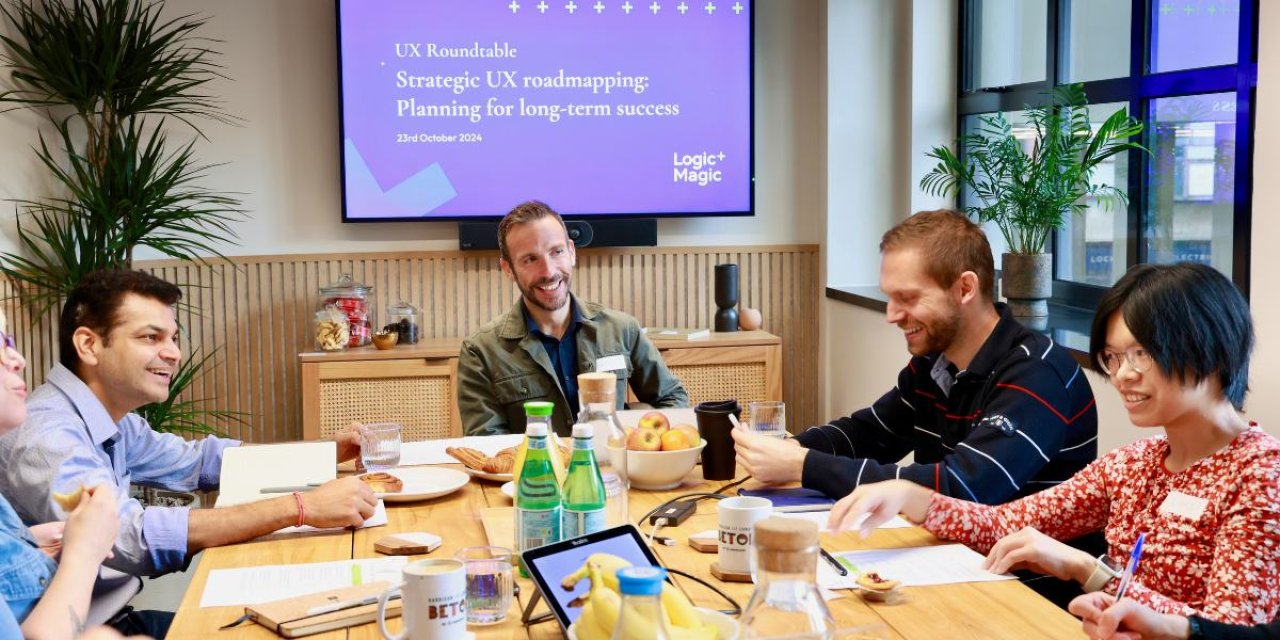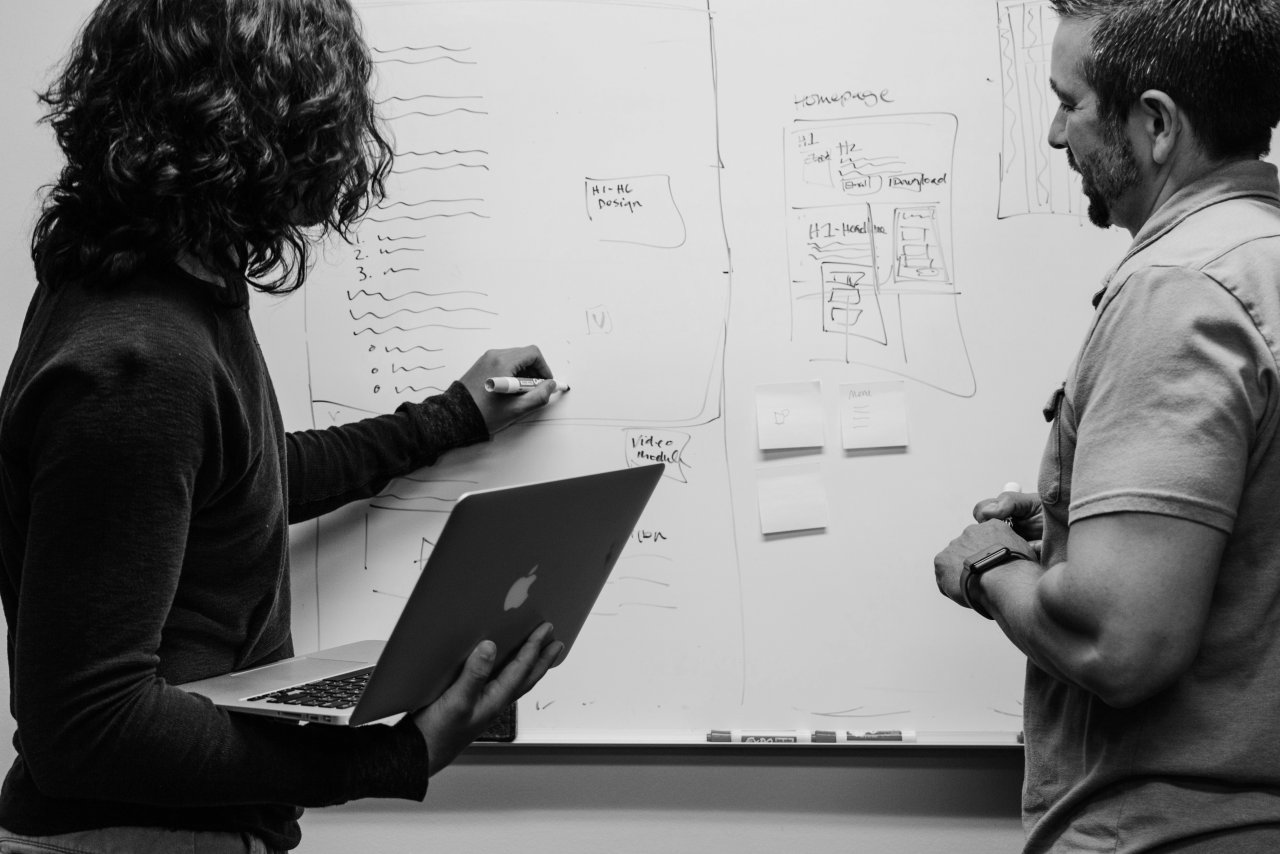Exceptional UX not only delivers superb user experiences but also amplifies customer satisfaction, propelling business growth. This principle extends beyond industry giants; every business, regardless of size, revolves around its customers and must prioritise their significance. As such, products and services should seamlessly intertwine ease of use, functionality, and aesthetic appeal. 2020 seen a transformative shift in the landscape of software applications, with customer experience emerging as the focal point. This paradigm saw pricing and product features take a backseat, highlighting the pivotal role of UX.
Despite this shift, we often find ourselves defending and selling the value our craft.
In early November Mark and Gareth from Logic+Magic were joined by 8 experienced senior UX leaders (Andreas Karamalikis, Ashleigh Robbie, Avinash Mair, Jon Warden, Jovita Tam and Paula Brezzo) in London who shared their perspectives on ‘Making an impact across the business’.
This blog summarises the ten key themes that emerged from that conversation.
Strategy
“Align design processes with organisational strategic direction and priorities.”
It’s not always obvious to colleagues that UX is an important component of strategy, or even a potential opportunity for competitive advantage. We need to align our work with strategic objectives and communicate that to our colleagues.
UX practitioners often master practical skills such as UI design, prototyping and wireframing, journey mapping, running user research, and reporting findings. While these skills are important, in order for UX to lead and influence at a higher level, practitioners must also grow their strategic skills and align design processes with organisational direction.
There was a feeling amongst the group that relaying the importance of the UX function can be tricky and so almost letting things break or being able to communicate the what ‘bad UX’ would look like are ways to really show the value and impact of work coming out of UX teams.
Leadership
“Seek to get a design voice at the top table.”
The world’s leading product design organisations have design representation in the C-Suite. Market leaders such as Apple and Amazon have founders obsessed by product. We need to help colleagues join the dots between design leadership and design performance.
Strategic leadership is a difficult space, we need to get better at presenting ourselves and how we communicate the value of UX talking in a language that resonates with the top table such as share price, brand loyalty, customer acquisition and innovation. Some participants shared that they’ve got themselves involved in commercial teams to get closer exposure on sales and marketing objectives and activities.
Culture
“Help your colleagues frame their work in the context of the users.”
This might well be the toughest challenge to influence because so much culture is set by CEO, Chair and board. We do however have the ability to influence culture within our teams and ensure that they are consistent in their framing, use of evidence and process when engaging with non-design colleagues.
We talked about managing expectations on balancing the perception of ‘just getting it done’ vs the requirement being really fleshed out and aligned with user need. There was a view that more organisations should adopt a start-up mentality that things must work or you’re dead, that way they could avoid basic mistakes of running fast by seeing the value in getting things that work, faster.
Innovation
“Connect future opportunity and competitive advantage with your design process”.
Many boards don’t spend time talking about design but most boards spend time talking about innovation. For UX leaders, those two concepts are virtually the same thing, so there is value is framing our work in the context of innovation and product development.
Innovation can be a bit of a double-edged sword. When it's not quite in sync, it has a knack for causing unintended confusion and frustration. Every stride forward, as exciting as it is, comes with its own set of potential pitfalls. Those shiny new interfaces that promise a revolution might end up leaving those accustomed to old paradigms feeling a bit alienated. And let's not forget the rush to innovate sometimes means the crucial step of comprehensive testing, leading to those pesky usability hiccups can be de-prioritised. Ethical considerations are a big deal too. Dark patterns, hidden intentions, and persuasive designs can easily transform tools into traps, essentially exploiting the very users they were meant to serve. Connecting innovation with empathy and responsibility can really push the boundaries; in a way respects and understands the user journey and thus creates more opportunity for the business.
Insight
“In god we trust. All others must bring data”
Many of our colleagues, particularly senior ones, move away from the customer front line as their careers develop. We have a unique opportunity to re-introduce them to their customers, through data and insight, with video insight being particularly impactful really bringing the user into the room.
Looking to articulate the value of UX? Share the return on investment, look at analytics and the customer experience. Business value = human experience.
People
“Design is the ultimate team sport. Create advocates across the business.”
Different people are roles being diverse perspectives to the table we must emphasise that we want everyone thinking about design but not doing design.
Developers should actively participate in the design process not only because it bridges the gap between vision and feasibility but because it signifies a fostering of shared understanding and alignment ultimately streamlining the overall product experience.
Just because ideas come from a user experience designer, researcher or project manager doesn’t guarantee its success. . Involving developers early in the planning and design stages is particularly beneficial due to their distinct problem-solving approach and can give different perspectives.
It’s important to keep the door open to ideas from employees in various roles, particularly those customer service, sales and marketing to gain diverse viewpoints.
Understanding
“Make it easier for others to understand your work by being deliberate around language..”
Sometimes the words we use mean different things to different listeners. Even the word design means deliberate evidence-led decision-making to us, but it might mean “painting and decorating” to colleagues! We need to evolve our vocabulary for impact. UX has more than its fair share of jargon.
To decide what to do with a particular jargon word, we need to consider two important questions:
Do my audience know this term and concept?
How important is it that I use this particular term?
Persuasion
“Empathise with colleagues as passionately as you empathise with users.
Despite the temptation to become frustrated, we should offer empathy to our colleagues, with their varying challenges, priorities and understanding of UX, in the same way we do to our users. We should be more carrot, less stick.
One participant commented:
“Internal PR and stakeholder management is a key part of our role. You simply can’t alienate people.”
Collaboration
“Design is too difficult to be the sole responsibility of the design team.”
Designers can’t do it alone! In fact, UX has lots to contribute to effective and efficient teamwork. Good collaboration gives us a perfect opportunity to “show don’t tell” with colleagues who may have the first opportunity not just to understand what we produce, but also how we think. Take that opportunity!
Communication
Be proactive in helping colleagues understand the contribution design makes.
For many disciplines in your business the value is obvious, often because output is produced. Programmers develop code, accountants produce management reports, but design doesn't always include output. Like insurance professionals we need to use future imagination (the price of bad UX, the opportunity of good UX) to enthuse colleagues.






.png)
